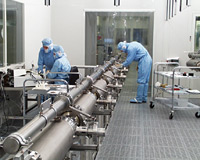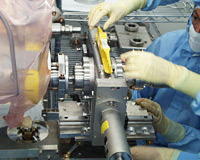 |
|||||||||||
|
|||||||||||
|
|||||||||||
|
Dust is never a welcome thing. But in DESY's cleanroom, where the cavities for the famous Module 6 are being assembled into a string this week, it is simply not tolerated: ten particles per cubic foot, that is all that is allowed. Any speck more would jeopardise the cavities' unique feature – their high gradient. So the seven DESY specialists working on the eight cavities are extremely careful, every touch is carefully engineered. The string that is being assembled this week is for Module 6 – the last in the line for FLASH, the European XFEL's pilot facility and paid for by XFEL funds and the Europe-funded EUROFEL project. "This one is a multi-purpose module," explains Axel Matheisen, leader of the cavity preparation and assembly group. It doesn't only serve its main future purpose, accelerating electrons in FLASH, but many others at the same time: "We're testing the working procedure to assemble the module. The industry is looking over our shoulder to see how the process can be turned into mass production, and they check whether things can be changed and improved," says Matheisen. But that's not it yet: two scientists from Fermilab are also at DESY to learn the process first-hand and use it for the first American module, to be built by the end of this year. And of course it's important lessons to learn for the XFEL which will need 128 of these modules, containing 1000 cavities. One string consists of eight cavities welded into their helium tanks, a beam position monitor and a quadrupole magnet. These cavities have been through the whole cleaning and testing process. The cavities for Module 6 are special because they have a very high gradient – the highest so far in the world at 30 to 35 MV per metre on multicells. After careful alignment and cleaning of individual parts, the first step is to fit a gatevalve to the outer cavity and the quadrupole. The technicians record the time it takes to complete each step to fine-tune the assembly instructions and find gaps for potential improvement. The whole assembly process takes about 10 days. "It is not actually the assembly that takes so long, it's all the cleaning and monitoring we do to ensure that the string is impeccable," says senior technician Birte van der Horst. Once the string is complete it will be inserted into the yellow vacuum vessel to become a module – NewsLine will continue reporting on the progress of Module 6, so watch this spot! -- Barbara Warmbein |
|||||||||||
| © International Linear Collider |

